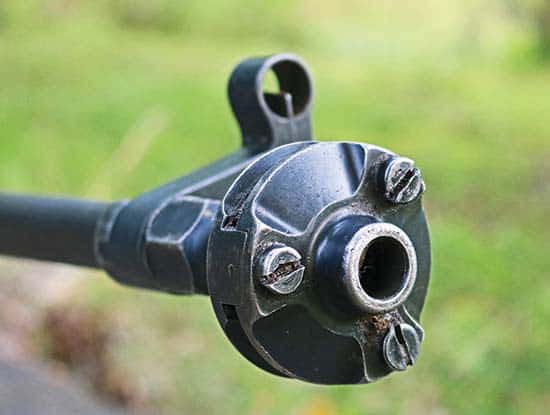Nobody really needs an anti-tank rifle. When I informed my long-suffering bride of the newest acquisition she just rolled her pretty eyes, shook her head, and wandered off to do something productive. You don’t buy an anti-tank rifle because you need it. You buy an anti-tank rifle because it’s just so freaking cool.
The rear sight is easily adjustable between 300 and 500 yards.
Descent Into Madness
It all began with an email from a dear friend. You know the type. The only thing better than spending your own money on something old, black and oily is spending your buddy’s money on something old, black and oily. He already had a Boys Rifle, so when he tripped over another he naturally thought of me. He dangled the thing in front of me like some kind of worm, and I gobbled it straight up without a fuss.
An anti-tank rifle is a Destructive Device. Never mind that it weighs as much as a Buick and shoots a ridiculously expensive antique round that has been out of production for more than half a century. In the eyes of the government it is Extra Special Dangerous (not a real federal classification so far), so it requires the same $200 transfer tax and interminable wait as might a machinegun or grenade launcher. At the terminus of all this hassle, however, this monster gun makes quite the fashion statement.
Back Story
The .55 caliber rifle was born in 1937 of one Capt. Henry C. Boys. Boys was the Assistant Superintendent of Design at the Royal Small Arms Factory in Enfield, England. The gun was originally supposed to be called the “Stanchion,” but Boys died a few days before the weapon was approved for service, so they named it after him.
The Boys Rifle was actually obsolete when it was introduced. Against early light tanks and tankettes (a real thing used fairly extensively by the Italians, French and Japanese) the weapon was relatively effective. In fairly short order, however, armored vehicle technology had rendered the rifle’s 47.6-gram bullet little more than an inconvenience.
Optimized rounds sported a tungsten core and travelled at around 2,800 fps. These hardened projectiles would penetrate just under 1″ of steel armor plate at 100 yards.
The Boys Rifle was liberally supplied to the Finns during their Winter War with the Soviets in 1939. The weapon was popular with Finnish troops as it could reliably deal with the T26 light tanks the Russians fielded at the time. It was also used extensively in North Africa. After the Battle of France, however, the Boys had developed a reputation for ineffectiveness that was getting tough to shake.
Desperate to restore confidence in the gun, the Canadian government contracted with Walt Disney in 1942 to create a short animated film titled Stop That Tank! It can be seen on YouTube and is pure unfiltered awesome. Hitler ultimately has his personal tank destroyed by a Boys Rifle and ends up in Hades alongside his pal, Satan.
The USMC purchased Boys Rifles from Canada prior to the Pearl Harbor attack and used them to destroy a pair of Japanese seaplanes off Makin Island. The widespread employment of the Browning M2 .50 HMG — which had comparable penetration — rendered the Boys superfluous.
The Boys Rifle was ultimately replaced by the PIAT (Projector, Infantry, Anti-Tank) in British service. The PIAT was a man-portable spigot mortar firing a shaped charge warhead that was hugely more effective against tanks.
The Boys Rifle was used sporadically throughout the war and saw limited use in a variety of brushfire conflicts around the Pacific afterwards. The last known combat use of the Boys occurred in September 1965 when members of the Irish Republican Army used a Boys Rifle to fire on the British fast-attack patrol boat HMS Brave Borderer, damaging one of its turbine engines. Nowadays Boys Rifles are only of interest to gun geeks like me.
Details, Details
The Boys Rifle weighs 35 lbs. (empty) and is just over 5 ft. long. It sports a conventional bolt action set into a spring-retarded sliding chassis that helps absorb the gun’s prodigious recoil. There were three variations built around the same basic action and my gun is the earliest sort.
The gun feeds from a top-mounted single-stack 5-round box magazine and sports iron sights that are flip-adjustable between 200 and 300 yards.
The odd forward cant of the two pistol grips accommodates the human form nicely, though there is no conceivable way to carry the Boys comfortably. Production culminated at 62,000 copies in 1940, and many available today have been rechambered to .50 BMG.
Heavy, inefficient, obsolete and cool, my Boys Rifle is now the epicenter of my gunroom.




